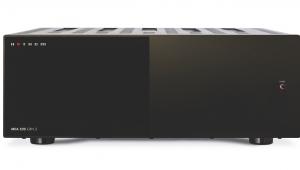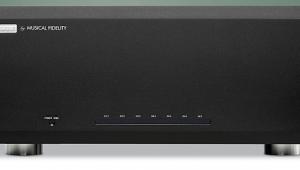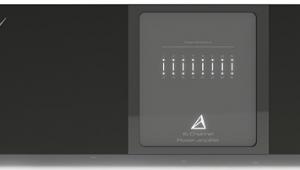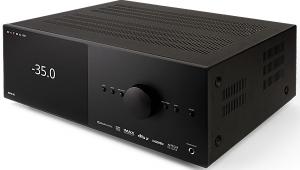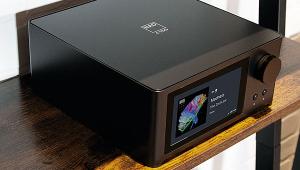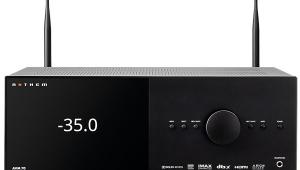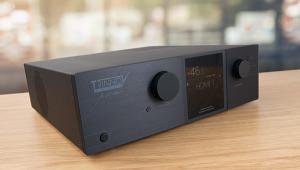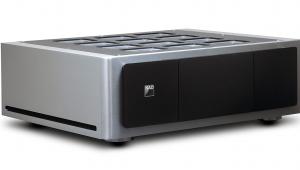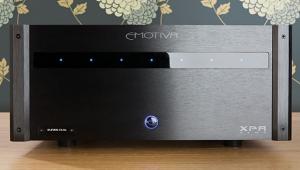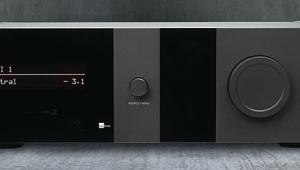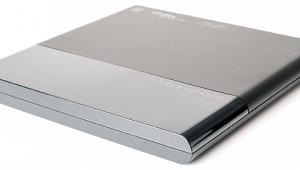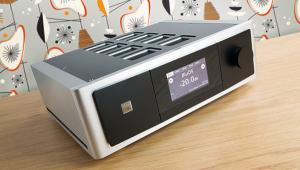Bryston SP3 review
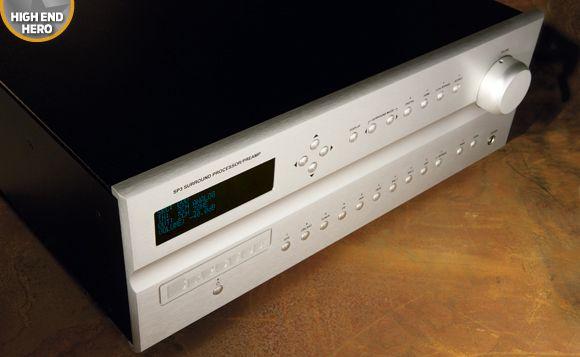
If I was able to trade body parts for AV goodies I would already be the Black Knight from Monty Python’s Holy Grail. But whilst I rolled around limbless on the floor I wouldn’t think twice about proffering a major organ for Bryston’s SP3 processor. Not only is it really rather special but, at ten grand, it’s the only way I am ever likely to afford one…
You see, Bryston has brought a rather different philosophy to the heady world of high-end home cinema equipment. Unlike other processors in the same wallet-wrenching ball park, such as Anthem’s DV2 or Denon’s AVP-A1HD, the SP3 is a minimalist design. It eschews the relentless feature-fest – and even quite basic functionality – of its competitors in its single-minded pursuit of the purist sound quality. Those very ideals have seen this Canadian AV company thrive at the serious end of the global hi-fi industry for over 35 years.
SplitterBryston’s SP3 aims to take in an HDMI signal and split out the LPCM or bitstream audio component. The video part of the HDMI passes clean through the SP3, unmolested, and on to the HDMI outputs. So there is no upscaling, no legacy analogue video-to-HDMI conversion, no colour, brightness or gamma processing – not even an onscreen menu display or GUI. Nothing. By implementing straight in/straight out video, Bryston has eliminated the need for high-speed video processing engines altogether. This stops any possible contamination of the audio signal and frees up R&D dollars for even more esoteric audio components.
I will admit that for many this could sound bonkers. The SP3 is a ten-thousand pound AV processor that doesn’t actually process the V bit. But it does make some sense, because if you are spending this sort of moolah on a processor then you are almost certainly spending a whole lot of cash on the very best video source equipment available, making any further image-fettling superfluous at best.
The audio portion of the SP3 is a very similar story of straight paths and minimal twiddling or tweaking. The digital stream is taken from the HDMI source (or S/PDIF from the coaxial and optical audio jacks), decoded and sent to the audiophile analogue output stages in the cleanest, most direct manner Bryston has found possible. This process is where Bryston’s audiophile heritage comes into its own as each of the seven output stages are designed as individual class-A pre-amplifier stages. The only user-adjustable sound parameters are channel delay, channel balance, bass management, lip-sync and overall volume. There is no Room EQ, no THX post-processing enhancements, no virtual speakers and no height or width channels. And as for features like networking, iPod docking or App control? Certainly not. Different, isn’t it?
The front panel is not the usual fair either. It is a huge slab of milled aluminium with a Bryston logo machined out, a four-line dot matrix display and an array of small chrome buttons. The remote control is just wild. It is machined out of a solid lump of aluminium so has a super heavyweight feel in the hand. The buttons click with a real mechanical integrity and sense of purpose.
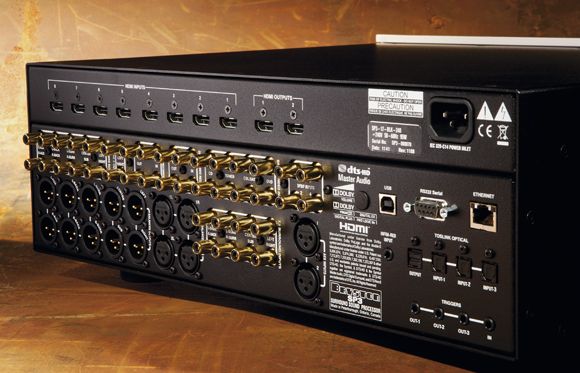
While all this sleek and minimalist style is an acquired taste, which I haven’t acquired, the rear panel is pure audiophile heaven. In addition to the 8-in/2-out HDMIs, the main analogue audio connections are all fully-balanced XLR terminals. There is also a wide array of phono line-level inputs and outputs, the aforementioned digital audio inputs and even a pair of AES/EBU digital inputs. As at least a nod to installation flexibility, there is a raft of 12V triggers and RS232 and Ethernet ports, although both of the latter are purely for CI control.
Under the sumptuous hood the design is no less different. The massive double-decker construction utilises completely separate power supplies for the digital processing and the analogue output stages. Not only does this over-engineered solution ensure signal integrity in both camps and negligible cross-talk between the two, it means that an analogue input signal can completely bypass the DSP stages. Feed it a stereo signal from a quality CD player or the analogue multichannel outputs of a top-spec Blu-ray spinner, and you get the same sort of signal purity out the other end as one would expect from a high-end stereo pre-amp. Now, to most home cinema aficionados that might seem a little excessive, but if you want the best in two-channel music reproduction and top-spec digital processing from a single device, the SP3 ticks all the boxes.
Interestingly, one of Bryston’s other claims to the SP3’s fame is its simplicity of use. Now I must have missed that one, because the set-up is a bit of a challenge. For starters, other than the nearly-as-bonkers T+A K8 I reviewed recently, I can’t remember the last AV processor, amp or receiver that I had to set up manually or without an onscreen display. You need to be pretty close to the green fascia display to read the small menus, which is not a problem for settings such as speaker distances but becomes a challenge where relative volume levels are concerned. You have to sit in your prime seat, listening or measuring the pink noise test tone, and reading 8mm tall text from across the room. Not possible with my old eyes, that’s for sure. Then again, some things are simple by featureless default. You don’t have to assign HDMI connections because the input numbers 1-8 represent the eight sources in that order on the front panel. Simple as that, in theory at least.
Okay, probably due to my intimate familiarity with highly automated and complex processors, I found using the SP3 something of a bugger to get used to. In one example of many, I spent ages trying to get the SP3 into multichannel mode as it would only output Blu-ray sound downmixed to stereo. As there is no ‘multichannel’ or ‘direct’ button on the remote or fascia, it transpires that you enable multichannel sound by pressing the ‘stereo’ button – to disable stereo mode. Go figure. And if that was in the manual, damned if I could find it. Ah, it’s just that sort of slightly frustrating quirkiness that makes the high-end of hi-fi such a fun place to be. I’m told.
Stereo stunner
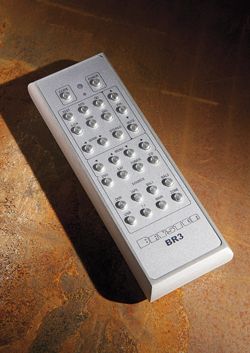 I borrowed a matching Bryston 9B five-channel power amp (£9,000) from UK distributor PMC for this test, and stuck on a CD while choosing some Blu-rays, just to warm things up.
I borrowed a matching Bryston 9B five-channel power amp (£9,000) from UK distributor PMC for this test, and stuck on a CD while choosing some Blu-rays, just to warm things up.
It took barely a few seconds before I had to stop faffing about and listen properly to the Bryston’s stereo performance. Laura Marling’s voice was right there in the room with me, presented in fantastic detail with presence that only a handful of amplifiers have ever delivered. And not one of those was an AV amplifier, they were all high-end two-channel designs. My own reference processor is the Denon AVP-A1HD (£7,500) and frankly the Bryston is in a different league with pure music.
The sound is deliciously inviting, each note crafted with such airiness and precision it is breathtaking. Bass has startlingly dynamic power and depth but it is at once spectacularly detailed and rich with texture.
Comparatively, the Denon sounds rather thicker and artificially weighty, while the Anthem DV2 is equally detailed yet lacks that very last breath of space between instruments that the SP3 delivers with consummate ease. It is a jaw dropper and hands down the best AV processor I have ever heard with stereo music.
Better still, much of that precision, power and sheer clarity translates directly into fantastic multichannel surround sound. Dialogue is crisp and enthralling with fabulous tone and depth. Through Kung Fu Panda each character is all but etched into the room. Jack Black, Dustin Hoffman, Angelina Jolie and Ian McShane sound, well, just like themselves with crystal-clear expression and timbre. Each voice is thrust into the room with three-dimensional body and the fine detailing never exhibits even a hint of artificial sibilance. This makes for an incredibly captivating movie-watching experience that absolutely delivers on the SP3’s promise of true high-end sound.
Wot, no EQ?Perhaps even more impressive is how Bryston’s processor sounds when the action really gets underway. As Tai Lung escapes from prison, the soundmix delivers a full-bore all-channel fiesta of effects. Unchecked by EQ, this scene often gets my room so excited that details get masked and various console controllers fall off the shelves. Yet even without the aid of EQ, the SP3 sounds amazingly taut under pressure, crafting a huge action sequence with admirable control. Each explosion has fast-paced dynamic attack backed with bone-shaking power. High-frequency effects leap clear of the chaos to ensure your hear absolutely everything coming off the disc.
By comparison, most AV receivers, even those costing up to £2,000 or so, sound congested, confused and muddled.
I switched between genres of movie and found that the SP3’s performance remained stellar throughout. Its sheer pace and clarity are breathtaking. Only Anthem’s DV2 has come close to creating such a stunningly incisive and open sound in my room and that beast achieves its performance in a very different way – by applying oodles of very accurate high-speed digital EQ. The result is that the Anthem sounds even tighter and more dramatic – but doesn’t match the SP3s stunning lucidity that separates every spoken word, effect and ambient detail with incredible space.
Clearly the SP3 is unfettered by any malaise caused by having loads of spurious RF from the video processing under the same bonnet. This allows the whole movie’s soundstage to soar into the room. Characters sound like they are there with you, effects sound like real events rather than a digital audio mock-up of what you are seeing on screen, and soundtracks have a definitive live presence. As such, the SP3 captures ‘mood’ with a rare sensitivity, irrespective of whether the film is an intense drama or Pixar family fun. It delivers all the angst and passion of Darren Aronofsky’s Black Swan like no other AV kit I have tried; as each scene unfolds you are drawn deeper into the plot, wholly affected by the emotions of the characters. Inspiring stuff.
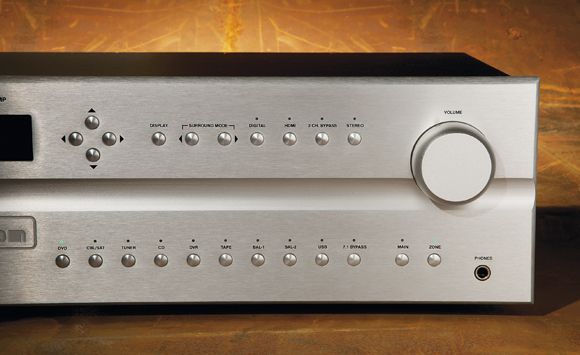
But there is a downside to the Bryston SP3, and not just the eye-watering price ticket. This processor is a purist device and its lack of features and quirky operation isn’t for everyone. Niceties that most of us take for granted on even budget receivers, like ease of operation and clearly understood GUIs, are missing. And more advanced functionality such as networking, streaming, height/width channel processing and HDMI ARC are never going to be part of this processor irrespective of future manufacturer upgrades. The lack of EQ may also cause unacceptable issues in some rooms – it did lead to some of my cinema’s nodes getting a little excited but they never became obtrusive – and a Bryston buyer is likely to be in the market for acoustic treatment, too.
However, I personally would accept these frustrations in return for the SP3’s incredible clarity every day. Rarely have I been so gutted to disconnect a review sample and hand it back. Bryston’s SP3 is odd, expensive, operationally frustrating and utterly, utterly brilliant.

HCC VERDICT
Bryston SP3
Price: £10,000 Approx
Highs: Stunning, class-defining stereo and movie sound; reassuring design and build quality
Lows: No features (pretty much at all); high price
Performance: 5/5
Design: 5/5
Features: 2/5
Overall: 5/5
Analysis
GUI: Erm, there isn’t one – unless you count the dot matrix display in the front fascia
Power consumption: We measured an average consumption of 50W, with a peak of 55W
Killer feature: The remarkable audio performance – partly because there are few other features of note...
Specifications
Dolby TrueHD: yes and Dolby Digital Plus
DTS-HD Master Audio: yes and DTS Neo:6
THX: No
Multichannel input: yes 7.1 channel
Multichannel output: yes 7.1 channel phono & XLR
Multi-room: yes one extra zone (audio)
AV inputs: yes 4 x coaxial and 3 x optical digital audio
HDMI: yes 8-in 2-out
Video upscaling: no
Component video: no
Dimensions: 440(w) x 393(d) x 160(h) mm
Weight: 11kg
Features: Audiophile quality construction and components; fully balanced audio; 12V triggers; Dolby Volume; RS232 CI control; digital-bypass pure analogue circuits; milled aluminium remote; factory 100-hour run-in; five-year guarantee.
 |
Home Cinema Choice #351 is on sale now, featuring: Samsung S95D flagship OLED TV; Ascendo loudspeakers; Pioneer VSA-LX805 AV receiver; UST projector roundup; 2024’s summer movies; Conan 4K; and more
|



